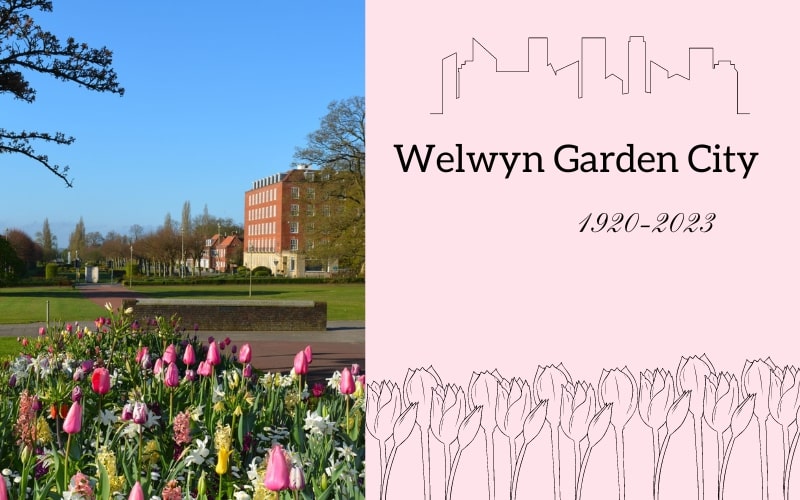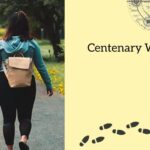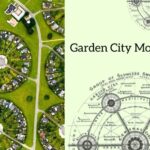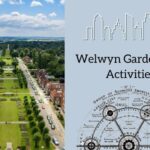In the heart of Hertfordshire, England, lies a gem that has stood the test of time, Welwyn Garden City. This remarkable town, celebrating its centenary, is a testament to the vision of urban planning and community living. From its inception in 1920 to the present day in 2023, Welwyn Garden City has been a beacon of garden city living, offering a unique blend of urban convenience and rural tranquility.
Paul Roberts former chair of the Welwyn Garden City Centenary Foundation introduces the first of an occasional series of articles published in the run-up to the centenary of Welwyn Garden City.
This, the first in a series of articles leading up to the centenary of Welwyn Garden City in 2023, reprints an introduction written by C B Purdom for Site Planning in Practice at Welwyn Garden City, a book by Welwyn’s masterplanners Louis de Soissons and Arthur Kenyon.
Published in 1927, the book contains a compendium of site plans and photos of the (then) new development that make for a fascinating and valuable record of the town’s evolution.
Purdom’s essay gives modern readers a revealing insight into the motivation of the Garden City forefathers. Purdom had been involved with the Garden City movement almost since its inception.
After being employed as an accountant for the First Garden City Company at Letchworth in 1902, he became enthused with the ideals of Howard and emerged as one of the movement’s most dedicated and eloquent activists.
Moreover, he combined a zeal for Howard’s vision for a better way of living with a sound financial approach. It is little wonder, then, that when Welwyn Garden City Ltd was formed to undertake the development of Welwyn, he was appointed Finance Director.
Purdom was actively involved in the life of the new town and the wider Garden City movement. A passionate supporter of local drama, he founded the Welwyn Theatre Society, illustrative of Welwyn Garden City Ltd’s mission to promote culture and social cohesion.
He held appointments as Honorary Secretary and then Treasurer of the International Federation for Housing and Planning as well as Secretary to the Garden Cities and Town Planning Association (equivalent to the Chief Executive of the Town and Country Planning Association today).
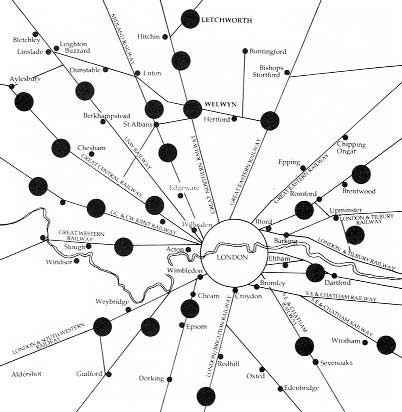
His plan for the 1920 Daily Mail Ideal Home Exhibition showing possible sites for ‘Satellite Towns Round London’ (see the illustration above) demonstrates the wider vision he possessed for the future of Britain’s towns and cities.
If Purdom were alive now, he would be in the vanguard of those seeking a solution to the problems of providing homes and jobs in sustainable developments. Today, we at least have the legacy of the wisdom of his writings. As the following article evidences, his words transcend the ages and give us a primer on the art and science of town planning.
- Paul Roberts is Chairman of the Welwyn Garden City Centenary Foundation. The views expressed are personal.
Site planning in practice at Welwyn Garden City
Introduction by C B Purdom
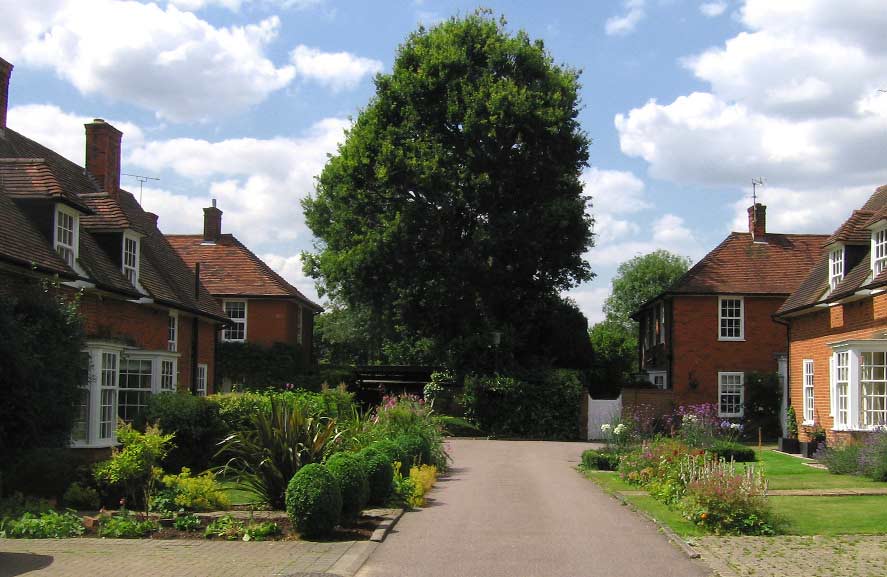
- Housing on Guessons Walk, built in one of the early phases of development at Welwyn Garden City
This book illustrates by plans and photographs the site planning and street design that have been carried out at Welwyn Garden City. It is a noteworthy record from many points of view. Welwyn Garden City was established just under seven years ago as an entirely new town.
The area selected for the town though near to London was rural, with no public services and few roads. The town is therefore a completely post-war undertaking, the plan and scope of the scheme and all the building and other work having been conceived and executed since 1922. It is thus to be regarded as an example of what can be accomplished under existing economic conditions. Welwyn Garden City was designed as a town for a population of the size of Colchester or Bedford.
It had to provide for houses of all kinds, both large and small, for shops and commercial buildings, public buildings, and industries. The idea was to accommodate a normal town population in such a way as to anticipate as far as is humanly possible the requirements of its inhabitants, securing the maximum advantages from planning the town as a whole, and enjoying the economy of working to a definite scheme.
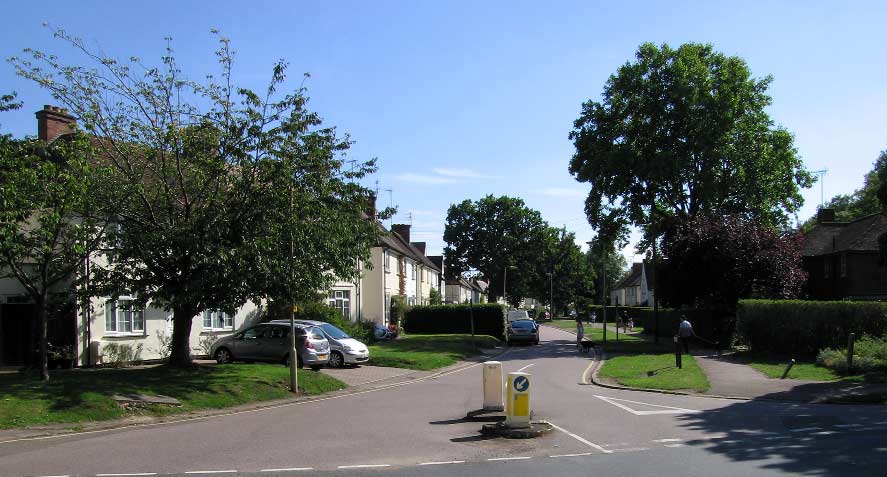
- Housing on Handside Lane today
This, of course, is the antithesis of the prevailing manner in which other towns have grown and still extend, and the results are likely to be different from what are seen elsewhere.
The present volume deals with one aspect only of the town, the planning of the residential area, and does not even touch upon any other feature of the scheme. What is presented here, however, is of the greatest interest. It is an account of practical work undertaken under the severest economic conditions and reaching a striking measure of success.
It should be understood that what is illustrated in the following pages is not a housing scheme in which considerations of cost and financial results were not of primary importance; but a series of building schemes that have been carried out under ordinary business conditions, and have proved commercially successful. These plans and photographs may therefore be studied as representative of commercial work made subject to a general plan.
In the planning of the residential area of Welwyn the natural contour of the land had to be taken advantage of and the architectural effect that was aimed at had to be secured by strictly utilitarian means.
There was no money for embellishments. The land had to be so laid out that the greatest amount of it could be developed at the lowest possible cost. The roads therefore follow the contours so far as that could be done while providing the main traffic routes. An examination of the plan will show certain roads made on a curve and others made straight.
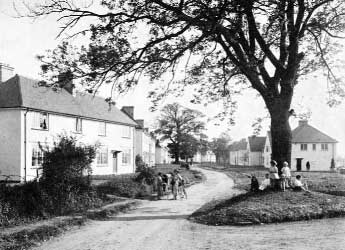
- Housing on Handside Lane shortly after completion in 1925 – curtesy of Welwyn Garden City Library.
This was not done on the drawing board to get a road scheme that looked well on paper; it is the result of following the natural conditions of the estate.
The site of Welwyn is gently undulating and well-wooded; but the area in which development was started in 1920, which is that illustrated in these pages, was fairly level, sloping gently to the south-east, and there was not a large number of trees upon it.
In the planning of this area the most careful use was made of all the existing timber; the position of each tree was marked on the surveys, and the road plans were prepared so as to get the utmost effect from the old oaks that were there.
A few trees were sacrificed; but not many. All the new roads were planted with trees, and many more trees were planted at the rear of the building plots. These trees are still comparatively small and do not show to much effect in the photographs; but the use of trees to get future effect has been very well thought out.
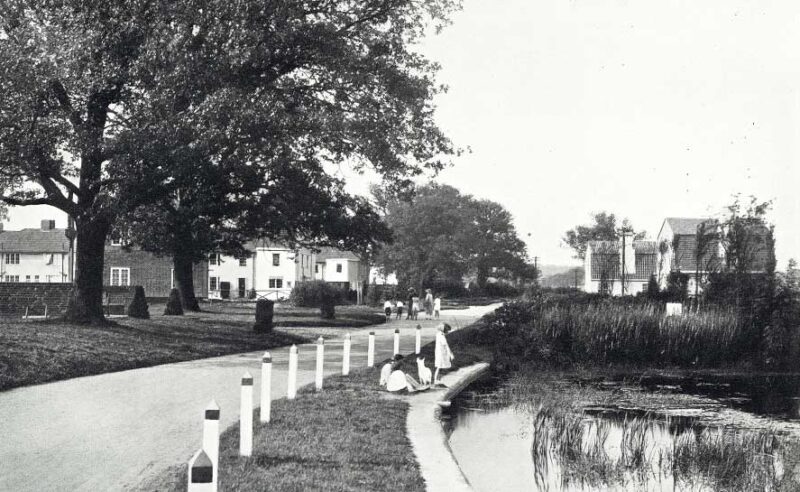
- Meadow Green – an illustration from Site Planning in Practice at Welwyn Garden City
Most of the street trees are of a small species, varieties of prunus, pyrus, and other small trees such as laburnum, thorn, etc., being used. At focal points in the plan large trees have been planted such as beech, lime, chestnut, etc., usually in groups of three or four at street corners, so as to make features in the street pictures in years to come.
Another interesting characteristic feature of the Welwyn lay-out is the use of ‘closes’ or ‘cul-de-sac’ roads. The usual way of developing land is to construct a series of secondary roads joining up the traffic routes; but at Welwyn such secondary through roads have been done without wherever possible, and the land has been developed by making short roads terminating in a small square or turning-point, building sites being placed on these roads.
These closes can be either curved or straight, and considerable variety can be secured in the lay-out of buildings upon them. They are primarily designed for economy in development costs; and they make most excellent building sites as the houses are off the main roads and the gardens are usually of a good size. The break in the street line where a close comes has to be treated to avoid an unsightly gap, and each close needs a terminal feature of some sort.
How these problems have been dealt with at Welwyn is shown in this book. The houses that have been built in the town range from £600 to about £3000, so that the component parts of the street effects are small detached or semi-detached houses, and a satisfactory result depends upon right placing of the buildings, flexible use of the building line, and particularly the maintenance of a cornice line throughout the street, both sides of the street being considered together.
Welwyn has gained much from this treatment, and the houses, while being made subordinate to the street effect, have gained individually too.
This should be contrasted with the usual method of allowing houses to be built without any relation to each other, the bad ones spoiling the good ones, the whole being incoherent and displeasing; or with the alternative method of building houses of the same design, perhaps slightly varied, side by side down a street, over-elaborated in ornament and emphasising their commonplaceness to the passers-by.
Welwyn has shown that the best results are to be secured by building schemes being carried out as consistent units. Many of the houses illustrated in the following pages are speculative building work; but they have been designed and built with care, with regard for appearance, and with the idea of contributing to the pleasantness of the town.
This has been done through the co-operation that has been brought about the architect, the builder, and the estate company. In this co-operation the distinguished architects who have prepared the material for this book have had a large share. The town of Welwyn Garden City is witness of their work, and this book will provide matter for study for those who have not seen it, and a valuable record for those who have.
- Site Planning in Practice at Welwyn Garden City, by Louis de Soissons and Arthur W M Kenyon, with an introduction by C B Purdom, was published by Ernest Benn Limited, London, 1927
The Legacy:
Today, Welwyn Garden City stands as a shining example of successful urban planning. It is a town that has not only survived but thrived, adapting to changing times while staying true to its original vision. The town’s success is a testament to the power of careful planning, community involvement, and a commitment to preserving the natural environment.
FAQs
What is the Garden City Movement?
The Garden City Movement was a revolutionary concept in urban planning initiated by Sir Ebenezer Howard. It aimed to create self-contained communities surrounded by greenbelts, combining the benefits of the city and the countryside.
Who were the masterminds behind the planning of Welwyn Garden City?
The town was planned by Louis de Soissons and Arthur Kenyon, who ensured that the town was not just a collection of buildings but a cohesive community.
What is unique about the layout of Welwyn Garden City?
The town’s layout follows the natural contours of the land, and the use of ‘closes’ or ‘cul-de-sac’ roads has contributed to the creation of peaceful, secluded residential areas.
Conclusion
As we celebrate the centenary of Welwyn Garden City, we pay tribute to a town that has stood as a beacon of garden city living for a hundred years. The town’s success is a testament to the power of visionary planning and community involvement.
Here’s to another hundred years of Welwyn Garden City, a town that continues to inspire and enchant with its unique blend of urban convenience and rural tranquility.
